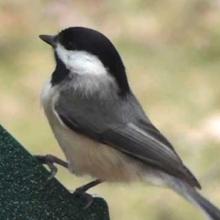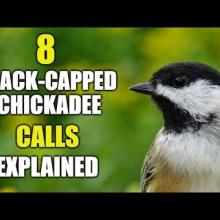

Join BirdNote tomorrow, November 30th!
Illustrator David Sibley and actor H. Jon Benjamin will face off in the bird illustration battle of the century during BirdNote's Year-end Celebration and Auction!
When it's just too hard to see the bird you hear, let your ears take over! Listen for the qualities of the sound as well as the pattern. A flute-like and upward-spiraling sound is characteristic of this Swainson's Thrush. Quite a contrast to the plaintively whistled notes of a Black-capped Chickadee. Maybe your bird has a raspy quality to its trill, like a Willow Flycatcher, while the ratchety song of a Marsh Wren cuts its way through the dense vegetation of a cattail marsh.
BirdNote®
Bird Sound Types and Qualities Part III
Written by Chris Peterson
This is BirdNote![Song of Swainson’s Thrush] Sometimes it’s just too hard to see the bird you hear. Too many leaves, too many pine needles, or maybe you’re looking into the sun. Still, you want to know what it is.
Well, relax your eyes and let your ears take over! Begin by listening for the qualities of the sound as well as the pattern. As you develop this skill, you’ll learn to link certain qualities with your singer – like knowing that a “flute-like” and “upward-spiraling” sound is characteristic of a Swainson’s Thrush.
[Song of the Swainson’s Thrush]
Quite a contrast to the “plaintively whistled” notes of this Black-capped Chickadee often found in the same habitat. [Song of the Black-capped Chickadee]
Maybe your bird has a “raspy” quality to its trill, like this Willow Flycatcher. [Song of the Willow Flycatcher] Or does it sing out using a “sweet” and “slurred” cadence like this Purple Finch? [Song of the Purple Finch]
OK, now which of these two qualities – “ratchety” or “ringing” – would you say describes the sound of this Marsh Wren [Song of Marsh Wren]? If you said “ratchety”, you’re right. The song of the Marsh Wren has to cut its way through the dense vegetation of a cattail marsh.
[Song of the Swainson’s Thrush to close]
Oh yah, “flute-like” and “upward spiraling.”
Hear them all again at birdnote.org.
###
Bird audio provided by The Macaulay Library at the Cornell Lab of Ornithology, Ithaca, New York.
Songs of the Swainson’s Thrush, Black-capped Chickadee, Purple Finch and Marsh Wren recorded by G.A. Keller. Song of the Willow Flycatcher recorded by M.J. Anderson.
BirdNote's theme music was composed and played by Nancy Rumbel and John Kessler.
Producer: John Kessler
Executive Producer: Chris Peterson
© 2014 Tune In to Nature.org May 2017/2022 Narrator: Mary McCann
sound-08-2008-07-16 sound-08b











